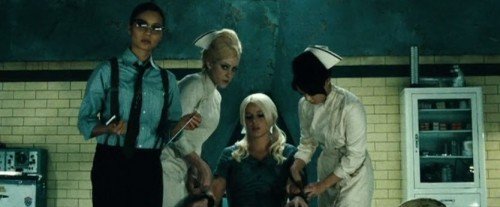Movies and TV
“Sucker Punch”: How to Make Monarch Mind Control Sexy

Sucker Punch is an action fantasy thriller that promises its viewers two things: girls and explosions. And it delivers both. But behind the slur of short skirts and CGI effects hides a disturbing underlying story: Sucker Punch is about the life of a mind control slave who dissociates from reality to escape the trauma caused by abuse. This article looks at the hidden meaning and symbolism in Sucker Punch.
Warning: This article deals with disturbing subject matters and contains major spoilers.
Produced by Zack Snyder (Watchmen, 300), Sucker Punch describes the quest of a girl attempting to escape a mental hospital where she was forcibly placed. In order to achieve this goal, our heroine, “Baby Doll”, and her friends, must find five items that will be used to escape the institution. Most critics did not appreciate the video game-like plot line of Sucker Punch and were confused its several levels of alternate realities.
The movie does come across as confusing because there is one important fact about this movie that is not known to most viewers that makes the movie (slightly more) cohesive and coherent: Sucker Punch is about trauma-based mind control. It tells the story of a victim of Monarch Programming (more specifically Beta or Kitten programming) as she becomes increasingly dissociative. The movie takes place in the slave’s psyche, where dissociation is a defense mechanism to escape the unbearable trauma of abuse. The deep dark secrets of Monarch mind control are never truly presented on screen yet they are implied in meanings and symbols throughout the movie.
(Note: If you are not familiar with Monarch programming, I suggest you read the article titled Origins and Techniques of Monarch Mind Control before continuing with this one).
Sucker Punch provides a taste of the confusion lived by actual MK slaves as the film subjects its viewers to some of the same mind twists: Illusion, deceit, reversal, and doublespeak. As the movie advances, the line between reality and fiction becomes increasingly blurry and messages become mixed up. At face value, the movie can be perceived as being about the empowerment of women, but the mind control symbolism of the movie indicates that it is actually about the exact opposite. Our hero Baby Doll is looking for “freedom” but, in the end, “freedom” is definitely not what she thought it would be. In fact, the entire movie can be understood in two completely opposite ways, making it quite a mind bender. Sucker Punch begins with an off-screen voice saying:
“Everyone has an angel. A guardian who watches over us. We can’t know what form they’ll take. One day, old man. Next day, little girl. But don’t let appearances fool you. They can be as fierce as any dragon. Yet they’re not here to fight our battles … but to whisper from our heart … reminding that it’s us. It’s everyone of us who holds the power over the worlds we create.”
Like many other parts of the movie, this introduction can refer to guardian angels helping people take charge of their life or to mind control handlers who have the power to manipulate the thoughts of MK slaves. This only one of the several possible double meanings in the movie.
Abuse at home
The movie takes place during the 1950-60s (despite glaring anachronisms), a period during which actual MK-Ultra experiments were known to be taking place. The main protagonist of Sucker Punch is a twenty-year-old girl known only as Baby Doll. Her name strongly suggests mind control: “baby dolls” do not control their movements or environments. Baby Doll’s background and road to mind control mirror the story of many real-life Monarch slaves: an abusive parent caused multiple traumas at a young age, making her predisposed to dissociation. Her “ownership” is then transferred to an institution where the actual programming takes place, under the supervision of specialists (handlers).
The story of Baby Doll is indeed the typical story of real-life Monarch slaves, who are often subjected to abuse at a young age. After several years of mistreatment, the ruthless parental figures have then no trouble handing over the children to MK authorities – clearing them of the possible criminal charges they could face for years of abuse.
The movie’s introductory sequences present Baby Doll’s source of trauma: an evil step-father.

Baby Doll’s drunk step-father looking to abuse her. Many Monarch slaves come from abusive households or multi-generational ritual abuse families.
“The type of father who is most preferred by the Programmers to offer up their children for programming is the phile. If a father will abuse his own little baby girl, then the Programmers know that the man has no conscience. This father’s involvement in criminal activity (and thereby his vulnerability) can be continually increased. They want men who they believe will not develop any qualms later on in life about what they have done.”
– Fritz Springmeier, The Illuminati Formula to Create a Mind Control Slave

The step-father’s wounds around the eye produce an emphasis on the “one-eye” symbol, which represents, as seen in other articles, Illuminati mind control. The one-eye symbol appears in other instances during the movie.
The step-father calls the police and accuses Baby Doll of killing her own sister – a crime he committed. She is arrested by the police and immediately drugged. Her ordeal as a Monarch slave begins.

Baby Doll is given a sedative by state officials and taken to the mental institution, which turns out to be a mind-control programming site. Mind-control slaves are constantly drugged by their handlers to facilitate their programming.
The Programming Site

Baby Doll forcefully taken into the institution. Several mental health institutions were actual mind-control sites used by the CIA.
The mental institution in which Baby Doll is placed has all of the characteristics of a mind-control programming site. The threat of physical and sexual abuse is constant during the entire movie and several techniques are used to trigger dissociation.
Music is extremely important in the institution (and in actual Monarch mind control) where it is used as a programming tool. Most of the songs heard during the movie have suggestive lyrics which, in the context of mind control, can to trigger dissociation. As Baby Doll is taken to her cell, Yoav’s cover of the song “Where is my Mind” is heard. The lyrics describe the feeling of dissociation:
With your feet in the air and your head on the ground
Try this trick and spin it, yeah
Your head will collapse
But there’s nothing in it
And you’ll ask yourselfWhere is my mind
Where is my mind
Where is my mind
In the institution, Baby Doll learns that her step-father paid to subject her to the ultimate form of mind control: a complete lobotomy. The administrator of the mental institution tells the step-father: “Don’t worry, she won’t even remember her name when I’m done with her”.
The movie then fast forwards to the scene of the lobotomy.

Lobotomies were performed by inserting a sharp instrument through an eye of the victim to “deactivate” the prefrontal cortex. The movie emphasizes the symbolism of the needle going through an eye to as it symbolically represents Illuminati mind control.
Right at the moment where the doctor is about to hammer the orbitoclast into Baby Dolls’ brain, dissociation occurs and the viewers are taken to an alternate reality. We are taken to the dissociative, imaginary world created by Baby Doll’s psyche, in which she embodies an alter persona: a Beta Kitten.
The Alternate Reality
In Monarch mind control, there are several types of programming, depending on the use the handlers want to make of the slave. In Sucker Punch, it is obvious that Baby Doll and her friends are subjected to Beta Programming – also known as Kitten programming. The emphasis in the beginning of the movie on her step-father’s abuse is, in Monarch Programming terms, the anchor.
“All the programming of each & every slave is anchored upon some type of trauma. One of the first fundamental traumas will be watched, filmed, coded & used as an anchor. For instance, the most brutal abuse of a girl by her father will be used as an anchor upon which to build the Beta programming. (…) Extreme psychosis is created within a child trying to deal with the issues created by the incest from the child’s most important figure–their father figure.”
– Ibid.
In Baby Doll’s alternate reality, the mental institution becomes a club run by a mobster – who is, in real life, the institution’s administrator. The “mental patients” of the institution are dancers…with extras. This distorted version of reality implies one important thing that is not directly mentioned in the movie: If Baby Doll deals in prostitution in her alternate reality, it implies that she is subjected to the same treatment in the mental institution. In actual Monarch programming, repeated and systematic abuse is used to create trauma and dissociation.
In her alternate reality, Baby Doll embodies an alternate persona – what is called a Kitten – who are programmed to give favors. The programming removes inhibitions and, as we’ll see, Baby Doll will be trained to “let herself go” and become sensual on demand.
It is during the scene of the lobotomy that we first see Baby Doll dissociating, turning the sordid operation into an alluring dance routine.

Baby Doll’s alternate world reflecting yet distorting her lobotomy – it is now the premise of an erotic dance routine.
Despite appearances to the contrary, the movie never truly condemns forced prostitution or even mind-control practices. Everything is turned into a fantasy, making the situation cool and attractive. For example, Baby Doll’s Kitten alter persona is constantly dressed as a schoolgirl who is brought in by a priest.

Baby Doll’s Sex Kitten alter has a different past. Real Monarch programming slaves are programmed to have different alters, who have different pasts, different attitudes and, sometimes, even speak using different accents than the “core” persona. In Baby Doll’s case, her abusive step-father becomes a priest.
Beta Kittens
In her alternate reality, Baby Doll is forced to dance and please clients. Since her alternate world is a product of dissociation, which “sugar-coats” reality to make it bearable, we can deduce that she is forced to do the same actual mental institution, but the movie never actually shows it.

Baby Doll is being told that she is here to please clients. Animal print cushions allude to Kitten programming.

Sweet Pea, another “patient”/slave, practicing her dance moves. She is wearing feline print, used in Monarch mind control to identify Beta Kittens.

Blondie, played by Vanessa Hudgens, also wears feline prints. Despite not being blonde, she is called Blondie, reflecting Kitten programming’s obsession with blondes (see Marilyn Monroe).
Vanessa Hudgens is a former Disney star; as stated in previous articles, there are numerous links between Disney’s child stars and Monarch programming.

Hudgens got this butterfly tattoo (which was highly publicized for some reason) around the time Sucker Punch was released. Tattoos are used in Monarch programming to identify slaves.
Mirrors and Butterflies
Not unlike other movies on the theme of mind control (see Black Swan), tricky mirror effects and confusing reflections are often used during Sucker Punch to symbolize the blurring of the line between reality and fiction and to give the viewers a small sense of the world of a MK Slave.

Tricky mirrors and camera movements cause viewers to realize that they were looking at inverted reflections during an entire scene – warning them to never trust what they see. Notice the butterfly between the mirrors, a symbol of Monarch programming.

When one of the slaves is shot and killed by Blue, the club the owner, the camera moves to an illuminated mirror from which falls a baby picture of her. Notice the butterfly.

Almost all films on mind control feature a shattered mirror at one point – representing the shattering of the slave’s personality. In Sucker Punch, the mirror shatters when Blue attempts to assault Baby Doll.
Second Level of Dissociation
So where do the cool action scenes fit in all this disturbing creepy mess? Well, they all happen in Baby Doll’s head as a way to escape reality. Each action scene occurs when Baby Doll is forced to perform an alluring dance.
Using music as a programming tool, Vera Grosky (the institution’s doctor who becomes the dance instructor in the alternate reality) tells Baby Doll to “let everything go”. In other words, she must dissociate. Following Vera’s orders, when the music starts, Baby Doll is catapulted into a second level of fantasy world. During the length of the song, the dance turns, inside Baby Doll’s head, into an imaginary action scene that vaguely reflects reality. This multiple level of dissociation is Baby Doll’s defense mechanism against the cold hard reality: the third level of the action scene means that she is dancing in the second level of the club, which means she is most likely being abused in the first level of the mental institution (I hope this is not too confusing).

During her first dance, Baby Doll dissociates to a world resembling feudal Japan. She is wearing a skimpy school girl outfit, reminding everyone that, behind all of this, the truth is that she is being used for her body.
During this first dissociative action scene, Baby Doll meets the “Wise Man”, the guide who will lead her to “freedom” … and I use that word in quotation marks for a reason. While it may appear that throughout the movie, the Wise Man guides Baby Dolls towards liberty, he knows all along that his help will lead her to the exact opposite – total lobotomy. More on this later.
The second action scene takes place in Germany, during WWI. Once again, Baby Doll is forced to dance. The song she must dance to is extremely meaningful: It is a remake of the classic song White Rabbit by Jefferson Airplane. In the context of mind control, the song’s lyrics take on a profound meaning:
One pill makes you larger
And one pill makes you small
And the ones that mother gives you
Don’t do anything at all
Go ask Alice
When she’s ten feet tallAnd if you go chasing rabbits
And you know you’re going to fall
Tell ’em a hookah smoking caterpillar
Has given you the call
Call Alice
When she was just smallWhen men on the chessboard
Get up and tell you where to go
And you’ve just had some kind of mushroom
And your mind is moving slow
Go ask Alice
I think she’ll knowWhen logic and proportion
Have fallen sloppy dead
And the White Knight is talking backwards
And the Red Queen’s “off with her head!”
Remember what the dormouse said;
“Feed Your Head”
This classic song can be interpreted in several ways but, in the context of this movie, it perfectly fits into the theme of mind control. As seen in previous articles, the movie Alice in Wonderland is used as an actual Monarch programming tool, where the slave is told to “follow the White Rabbit” through the Looking Glass – the Looking Glass equalling dissociation. For this reason, the symbol of the white rabbit became an important symbol of mind control in popular culture.

In the WWI action scene, the girls ride a “mech” that prominently features the MK symbol of the white rabbit.
The other action scenes follow the same pattern: A dissociative song triggers Baby Doll to go into a fantasy world where she must accomplish a mission. Each mission is a distorted version of the real-life mission she and her friends must accomplish to, in the end, escape the institution and find freedom.
The girls succeed and obtain the items required, but not without deaths and sacrifices along the way.
Going to “Paradise”
During the entire movie, Baby Doll’s only goal is to “leave this place” and to “be free”. On numerous occasions, the process is referred to as “going to Paradise”. However, like actual Mind Control slaves, the viewers of the movies are confused with deceitful double-speech and inversions – using attractive words to describe horrible realities. In the movie, “Paradise” and “Freedom” do not equal escaping the mental institution, but rather signify complete dissociation from reality. The Wise Man who seems to be guiding Baby Doll toward “freedom” actually leads her to the acceptance of her lobotomy as the only way to truly “be free”.
This disturbing ending reflects the even more disturbing reality of Monarch slaves: even if they escape the grips of their handlers, they cannot escape the suffering and the trauma they have been subjected to. Baby Doll apparently realizes this fact. So, in the end, instead of escaping the institution with her friend Sweet Pea, Baby Doll acts as a true hero and sacrifices herself to free her friend, creating a diversion that allows her friend escape. Baby Doll is seized and taken to be lobotomized.
After the doctor performs the lobotomy, he says:
“Did you see the way she looked at me? Just in that last moment. It was like … she wanted me to do it”.
At least, Baby Doll’s sacrifice allowed Sweet Pea to escape the institution and be free, right? Not so sure.
After the escape, Sweet Pea is shown at a bus station about to leave town. When she enters the bus, a boy, who looks oddly familiar, looks at her.

The weird random kid at the bus station is the same weird random kid that appeared in the WWI scene. Since that scene was a result of dissociation, is the scene of the bus station also imaginary?
When Sweet Pea boards the bus, she realizes that the bus driver is the Wise Man who guided Baby Doll toward her lobotomy. He tells her to get some rest because she has “a long way to go”. Is he leading her to freedom or to a dissociative “paradise”?
MK Merchandise
Here are some officially licensed Sucker Punch t-shirt designs that contain their fair share of Illuminati mind control symbolism.

The teddy bear with stitched forehead and buttons instead of eyes represents children MK slaves and their loss of innocence.

Another shirt design featuring an emphasis on one eye. Dangling from the sword is the “key” to Baby Doll’s freedom…dissociating into fantasies.
In Conclusion
Most moviegoers come out of Sucker Punch believing that its a movie about “empowerment”, “women fighting back” and whatever other buzzwords they’re using these days. While some might perceive Baby Doll as a strong woman fighting back against the oppression of men, others might conclude that the movie caters to the perversions, turning them into a fantasy. The same double-speak can be attributed to the movie when relating to the theme of mind control. While the main message of the movie appears to be about “fighting for freedom”, a deeper look at the movie reveals that it might be saying the opposite. In the end, Baby Doll’s “battle” was not one of rebellion and freedom, but for escape and dissociation. Her “guide” was not an agent of liberation, but a handler who owned the keys to her psyche, guiding her into the fracturing of her personality.
The final words of the movie, said by an off-screen voice, also play on reversals and double-speak. Is it an empowering speech on self-determination or a description of the handler’s complete control of the slave’s psyche?
“Who honors those we love with the very life we live? Who sends monsters to kill us and at the same time sings that we’ll never die? Who teaches us what’s real and how to laugh at lies? Who decides why we live and what we’ll die to defend? Who chains us? And who holds the key that can set us free?”
The movie ends with the same words Baby Doll was told before dancing and dissociating the first time.
“It’s you. You have all the weapons you need. Now fight.”
Through illusion, deceit, and double-speech, the viewers witness a subtle promotion and glorification of the very things the movie apparently goes against. I guess this is why they called the movie Sucker Punch.
- Anybody Else See The Hidden Meaning?
- Gossip vlogger Kyle Marisa Roth, who recently exposed celebrities like Diddy, suddenly d!es at 36
- Thousands of Japanese Protest WHO "Pandemic Treaty," Which Grants Globalists Sweeping Worldwide Powers to Enact Lockdowns, Travel Restrictions, Food Rationing, Censorship and More.
- Is this a "coincidence"?
- People Stunned By One More Bizarre Bianca Censori Look As She Walks Barefoot Around Disneyland
- Top 100 ‘Conspiracy Theories’ That Became ‘Conspiracy Facts’
- Post-Modernists are the True Crazy Conspiracy Theorists
Get an e-mail notification as soon as a new article is published on The Vigilant Citizen.
-

 Latest News3 months ago
Latest News3 months agoThe Top 6 Most Deranged Moments of the WEF’s 2024 Davos Meeting
-

 Vigilant Reports2 months ago
Vigilant Reports2 months agoSuper Bowl 2024 Was a Circus Involving a Clown Wearing an Inverted Cross
-

 Movies and TV2 months ago
Movies and TV2 months ago2024 Grammys: It Had To Be All About Taylor Swift. It Just Had To.
-

 Pics of the Month3 months ago
Pics of the Month3 months agoSymbolic Pics of the Month 01/24
-

 Pics of the Month2 months ago
Pics of the Month2 months agoSymbolic Pics of the Month 02/24
-

 Movies and TV1 month ago
Movies and TV1 month agoThere’s Something Terribly Wrong With “Poor Things”
-

 Music Business3 weeks ago
Music Business3 weeks agoThe Blatant Luciferian Symbolism in Justin Timberlake’s “No Angels”
-

 Music Business2 months ago
Music Business2 months agoPoppy’s “V.A.N”: One of the Most Blatant MKULTRA Videos Ever Made























